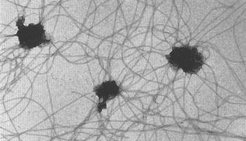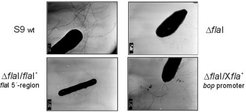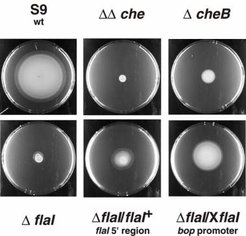Flagella of Halobacterium salinarum and their biogenesis
Like many unicellular organisms the halophilic archaeon Halobacterium salinarum posseses flagella, which - in combination with a sophisticated sensory system (see transducer proteins and CheAY-two-component systems) - enable this organism to swim and find places with optimal growth conditions. The target of the sensory system is the switch of the flagellar motor.
The knowledge about eubacterial flagella and flagellar motors is very detailed. Of the archaeal flagellar apparatus however, only a few poorly defined structures have been described so far. All presently available data clearly indicate that the archaeal flagellar apparatus is completely different from the eubacterial one in many respects (Thomas et al., 2001), although both motility systems are based on the principle of rotating flagella. We are interested to find out more about the flagellar apparatus of H. salinarum which might represent a model system for other archaea.
Depending on the growth phase the majority of H. salinarum cells are either monopolarly or bipolarly flagellated (Alam and Oesterhelt, 1984). A flagellar bundle consists of 5 - 10 filaments forming a right handed helix. The flagella are inserted into a distinct polar cap structure (Kupper et al., 1994) and it is likely that every filament posesses its own flagellar motor.

Halobacterial cells are pushed forward by clockwise and pulled backward by counterclockwise rotation of the right handed flagellar bundle. Rotation and switching of the flagellar motor assembly have been studied extensively (Marwan et al., 1991).
Flagella of H. salinarum consist of 5 different flagellins FlgA1-A2 and FlgB1-B3 (Alam and Oesterhelt, 1987; Gerl et al., 1989), which are encoded by two separate transcriptional units. The flagellins show no homology to known eubacterial flagellins and are posttranscriptionally glycosylated (Wieland et al., 1985). Further genes involved in the biogenesis of halobacterial flagella are found in the fla gene cluster. Deletion of flaI showed that this gene is essential for the biogenesis of flagella (Patenge et al., 2001).


The fact that immature flagellins contain a cleavable signal peptide and the homology of halobacterial FlaI to P. aeruginosa PilB revealed that biogenesis and assembly of archaeal flagella are rather related to the eubacterial type IV pili secretion system than to the type III secretion system involved in the assembly of eubacterial flagella.

Unlike in Eubacteria, where the flagellins are transported through the hollow core of the filament, archaeal flagellins are supposed to be assembled at the base of the flagellum. Halobacterial flagellar filaments are only about half as thick as their eubacterial counterparts and in a recent model of the halobacterial flagellum the filament lacks a central channel (Cohen-Krausz and Trachtenberg, 2002).
We are attempting to identify yet unknown components of the flagellar motor and the assembly-machinery of H. salinarum flagella by means of molecular biology, proteomics, bioinformatics and transcriptomics.
References
-
Alam, M. and Oesterhelt, D. (1984)
Morphology, function and isolation of halobacterial flagella.
J. Mol. Biol., 176, 459-475. -
Alam, M. and Oesterhelt, D. (1987)
Purification, reconstitution and polymorphic transition of halobacterial flagella.
J. Mol. Biol., 194, 495-499. -
Cohen-Krausz, S. and Trachtenberg, S. (2002)
The structure of the archeabacterial flagellar filament of the extreme halophile Halobacterium salinarum R1M1 and its relation to eubacterial flagellar filaments and type IV pili.
J. Mol. Biol., 321, 383-395 -
Gerl, L., Deutzmann, R. and Sumper, M. (1989)
Halobacterial flagellins are encoded by a multigene family-Identification of all five gene products.
FEBS Letters, 244, 137-140. -
Kupper, J., Marwan, W., Typke, D., Grünberg, H., Uwer, U., Gluch, M. and Oesterhelt, D. (1994)
The flagellar bundle of Halobacterium salinarium is inserted into a distinct polar cap structure.
J. Bacteriol., 176, 5184-5187. -
Marwan, W., Alam, M. and Oesterhelt, D. (1991)
Rotation and switching of the flagellar motor assembly in Halobacterium halobium.
J. Bacteriol., 173, 1971-1977. -
Patenge, N., Berendes, A., Engelhardt, H., Schuster, S.C. and Oesterhelt, D. (2001)
The fla gene cluster is involved in the biogenesis of flagella in Halobacterium salinarum.
Mol. Microbiol., 41, 1-12. -
Thomas, N.A., Bardy, S.L. and Jarrell, K.F. (2001)
The archaeal flagellum: a different kind of prokaryotic motility structure.
FEMS Microbiology Reviews, 25, 147-174. -
Wieland, F., Paul, G. and Sumper, M. (1985)
Halobacterial flagellins are sulfated glycoproteins.
J. Biol. Chem., 260, 15180-15185.



